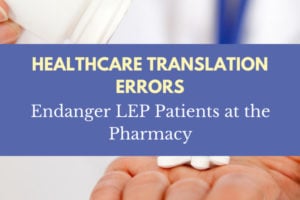According to the Mayo Clinic, "hundreds of thousands of people" are injured by medication errors every year in the United States. Some of those errors are caused by doctors prescribing the wrong medications, or by pharmacists dispensing the wrong medication or the wrong dose. However, a significant number of medication errors happen because patients are confused about how to take their pills correctly.
Studies show that it's difficult for even native English speakers to understand the directions on their pill bottles. According to a study published on Healthcare.gov, around 35% of Americans aren't "health literate" enough to interpret a prescription label accurately.
So what about patients with low English proficiency? Currently, only California and New York require prescription labels to be translated into languages other than English. That said, some major pharmacy chains do offer translated labels even in states where it's not required. Unfortunately, that doesn't mean those translations are accurate.
Healthcare Translation Errors at the Pharmacy Are Disturbingly Common
Even where translations are available, they are often riddled with errors. For example, in a 2010 study published in Pediatrics, researchers reviewed Spanish-language prescription labels from pharmacies in the Bronx. Half of them contained errors.
According to Medicine.net, most prescription label translations from the study were computer-generated. These translations had three major types of errors:
Spanglish
Many of the prescription labels referenced in the study weren't even entirely in Spanish. That could be confusing for LEP Spanish speakers. Even more concerning were "false cognates" like the English word "once" and the Spanish word "once." In Spanish, "once" means "11," and there's a big difference between "take once a day" and "take 11 a day."
Typos and Incorrect Spellings
Some words were frequently misspelled, like "poca" (little) instead of "boca" (mouth). These errors resulted in instructions like "take by the little" instead of "take by mouth."
Complete Gibberish
Sometimes, what came out was nothing more than gibberish. Here are three examples referenced in the study:
- "Take 1.2 aldia give dropperfuls with juice eleven to day."
- "Taking 0.6 mL two times to the day by the little with juice."
- "Apply to affected area twice to the indicated day like."
That study was from 2010. Have things improved since then? Not much. Although California does provide vetted translations of the most common prescription label instructions, not all pharmacists use them.
Instead, according to a February article on MedShadow.com, most translations are automatically generated based on information provided by third-party aggregators. According to MedShadow:
The result is a patchwork of words with the same English phrase reading multiple ways in the new language, depending on the pharmacy and the drug.
How to get the details right in healthcare translation
In medical and healthcare translation, details matter. Machine translation can undoubtedly be helpful, but quality control from skilled translators is a must. Many of the same guidelines that we advise for managing international content would also help here, like using simple language and consistent terminology in the English versions of prescription labels.
Incidentally, following these guidelines would also make the instructions more accessible for English speakers. However, getting the entire medical profession on board with following these guidelines is likely to take time.
Meanwhile, providers and pharmacies should make sure that patients know about options like interpreter lines to explain prescription labels orally. Providing additional information such as brochures can also be helpful for informing patients and improving overall health literacy.
At United Language Group, we are experienced in all aspects of healthcare and medical translation and compliance. Our skilled team, specialized technology, and award-winning project management process can help your organization meet its language access goals, on time and on budget.
Does that sound good to you? Then contact us at 1-855-786-4833. We'd love to talk!
Health Literacy, Healthcare, Healthcare Translation, Prescriptions

